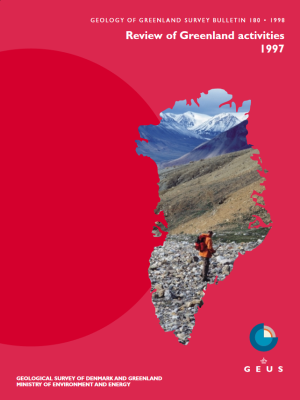Wandel Sea Basin, eastern North Greenland
DOI:
https://doi.org/10.34194/ggub.v180.5086Abstract
The Wandel Sea Basin in eastern North Greenland is the northernmost of a series of fault-bounded Late Palaeozoic – Early Tertiary basins exposed along the eastern and northern margin of Greenland (Fig. 1). The basin and the surrounding shelf areas are located in a geologically complex region at the junction between the N–S trending Caledonian fold belt in East Greenland and the E–W trending Ellesmerian fold belt in North Greenland, and along the zone of later, Tertiary, continental break-up. The Wandel Sea Basin started to develop during the Carboniferous as a result of extension and rifting between Greenland and Norway, and Greenland and Spitsbergen (Håkansson & Stemmerik 1989), and was an area of accumulation during the Early Carboniferous – Early Tertiary period. Two main epochs of basin evolution have been recognised during previous studies of the basin fill: an early (late Palaeozoic – early Triassic) epoch characterised by a fairly simple system of grabens and half-grabens, and a late (Mesozoic) epoch dominated by strike-slip movements (Håkansson & Stemmerik 1989). The Mesozoic epoch only influenced the northern part of the basin, north of the Trolle Land fault zone (Fig. 1). Thus the northern and southern parts of the basin have very different structural and depositional histories, and accordingly different thermal histories and hydrocarbon potential. This paper summarises the results of a project supported by Energy Research Program (EFP-94), the purpose of which was to model the Wandel Sea Basin with special emphasis on hydrocarbon potential and late uplift history, and to provide biostratigraphic and sedimentological data that could improve correlation with Svalbard and the Barents Sea. It is mainly based on material collected during field work in Holm Land and Amdrup Land in the south-eastern part of the Wandel Sea Basin during 1993–1995 with additional data from eastern Peary Land (Stemmerik et al. 1996). Petroleum related field studies have concentrated on detailed sedimentological and biostratigraphic studies of the Carboniferous–Permian Sortebakker, Kap Jungersen, Foldedal and Kim Fjelde Formations in Holm Land and Amdrup Land (Fig. 2; Døssing 1995; Stemmerik 1996; Stemmerik et al. 1997). They were supplemented by a structural study of northern Amdrup Land in order to improve the understanding of the eastward extension of the Trolle Land fault system and possibly predict its influence in the shelf areas (Stemmerik et al. 1995a; Larsen 1996). Furthermore, samples for thermal maturity analysis and biostratigraphy were collected from the Mesozoic of Kap Rigsdagen and the Tertiary of Prinsesse Thyra Ø (Fig. 1).
Downloads
Published
Issue
Section
License
This article is distributed under a CC-BY 4.0 licence, permitting free redistribution and reproduction for any purpose, even commercial, provided proper citation of the original work. Author(s) retain copyright over the article contents.


